A young teacher talks about what it’s like to work with the children at ISKCON’s primary school in Los Angeles.
—by Dvarakanatha dasa
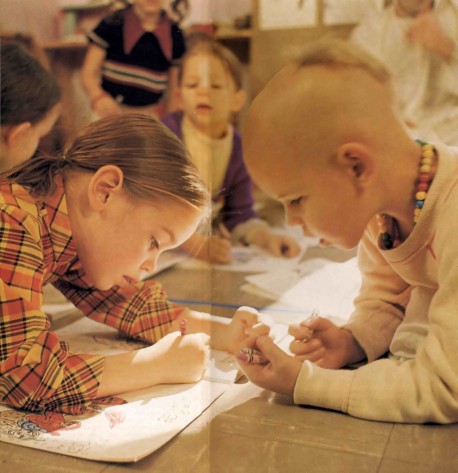
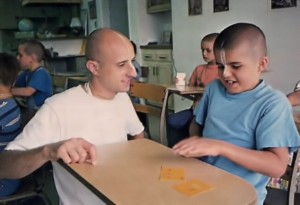 When I started working as a counselor, I began spending more time with the children. I was surprised to find out how difficult it was, and how much responsibility I’d taken on. Before, I’d taken care of the children on an academic level, and then on an executive level, but now I had to tend to their more personal spiritual and material needs. The boys I worked with were between four and eight years old, and I had to see that they stayed orderly and clean, that they learned how to take care of themselves physically, and that they also took care of their belongings (clothing, crayons, books, and so on). And their living space had to be kept up, too. Also, because Gurukula’s standard of personal behavior is very demanding—in a sense, higher than what most adults are accustomed to—I had to set a good example of behavior for the children to follow.
When I started working as a counselor, I began spending more time with the children. I was surprised to find out how difficult it was, and how much responsibility I’d taken on. Before, I’d taken care of the children on an academic level, and then on an executive level, but now I had to tend to their more personal spiritual and material needs. The boys I worked with were between four and eight years old, and I had to see that they stayed orderly and clean, that they learned how to take care of themselves physically, and that they also took care of their belongings (clothing, crayons, books, and so on). And their living space had to be kept up, too. Also, because Gurukula’s standard of personal behavior is very demanding—in a sense, higher than what most adults are accustomed to—I had to set a good example of behavior for the children to follow.
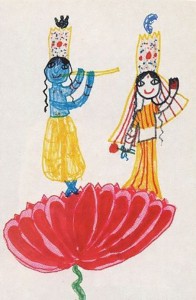
After a short time, though, working so closely with the children got to be very wonderful, because I could see them spontaneously growing more and more Krishna conscious in their daily activities. Inside the classroom they were a bit formal, but outside the classroom they showed their advancement spontaneously. I could tell that they were naturally becoming devotional: they wanted to serve, and they were very friendly. Sometimes I felt personally very moved by this. They’d give me presents (whatever little things they had), and when a new boy would move in, the others would treat him like an old friend and help him out by teaching him the ropes.
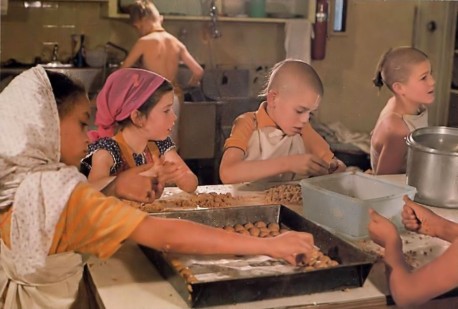

Once, when I told the children that Krishna consciousness is practical, they asked what I meant by that. I explained that just as they have many chores and duties to perform (folding their clothes, cleaning their rooms, going to school, and so on), other children all over the world have the same kinds of chores to do. So, I told them, whether they were at Gurukula or not, they’d be doing these things anyway. But at Gurukula, because they’re doing these simple things for Krishna, they’re advancing spiritually. Right away they understood, and they appreciated this idea very much. I was surprised that they caught on so quickly, but Srila Prabhupada has said that these children, for the most part, have taken birth in ISKCON especially to finish up their devotional service. In their last life they didn’t quite perfect it, so this time they’ve been given the association of devotees from an early age. It is because of this previous experience that they so much appreciate being engaged in Krishna’s service.
Another thing the children appreciate a lot is their schedule. Aft all, human beings are creatures of habit. We like to have our activities regulated. If we have no plan in on daily lives, then we’re always in anxiety, wondering what’s going to happen next. So, having a schedule makes life simple for the children at Gurukula, because they know what they’re going to be doing during the day. We feel they need this sense of security. But their schedule isn’t so regimented that they lose their personal identity. There’s still variety—some days we alter the usual schedule. By contrast, a very common situation in America today is that both the parents work and the children have to come home to an empty house. They have to get their own food, don’t know what to do, watch tv. Very often they end up getting into trouble. But the Gurukula children are very well taken care of. I think you’ll find that when a child is well taken care of, his day is well structured. His parents don’t want him to run wild. So, some people think our children are forced to behave in a way we impose on them, but in reality we’re just giving them the care they want and need.
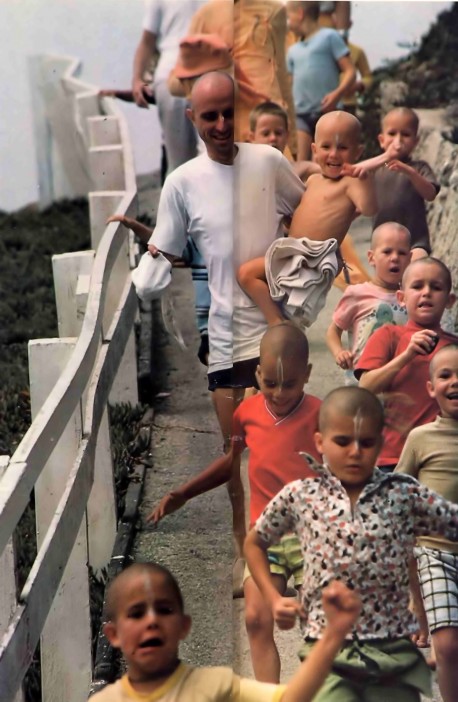
True, by usual American standards, their life is austere. But isn’t this good? Haven’t so many of us, children of the affluent society, complained that our upbringing was too soft? Our parents handed us everything on a silver platter; we didn’t have to work for it. That was bad for our character. A lot of times we had to invent obstacles to overcome, just to develop some moral fiber. We had a lot of pleasures, maybe, but they were all meaningless, purposeless. At Gurukula, though, the children are getting pleasure from something different—purposeful service to the Lord, and to humanity. They don’t just agitate their senses by watching tv or playing with more toys than they need.


For most kids toys are a very important part of life. But not for our children. They have just a few simple things, like blocks, balls, things for digging in the sand. Beyond these, they use their imagination to make toys. They’re more self-reliant than the usual, pampered child. They use sticks and things—whatever they can find. They’re naturally happy by just using their imagination and creativity. Also, rather than solving their problems for them, I try to get our children to figure things out for themselves. I could take the easy way out by just giving them something else to distract them, or by just buying another toy. But when they have to solve their problems in their own way, the result is much more satisfactory.
One thing the children like very much is to reenact Krishna’s pastimes. While I was with the four- and five-year-olds in Dallas, every day after the morning services we used to play in a sunny upstairs hallway. I would let the children play freely while I chanted Hare Krishna on my beads. The whole time they’d put on plays of Krishna’s adventures. One boy was a good leader, and, using me as the audience, he’d organize the others in some pretty good dramatic performances. They were simple skits—one day a cardboard box became Matsya, the fish incarnation. A couple of boys climbed in as the personified Vedas, and they went swimming around the hallway. For another play, the boys used two steps leading up to the bathroom as a chariot. Four boys got in front as horses, and Krishna and Arjuna rode their chariot on the Kuruksetra battlefield.
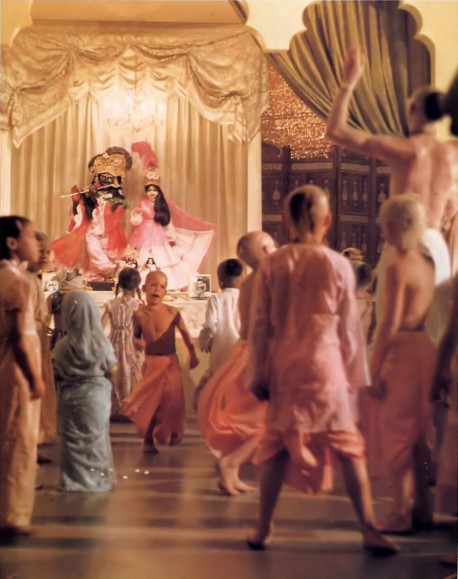
Of course, when there is a toy around, they’ll play with it, because toys are designed to attract children. So they play with it for a while. But they usually get little satisfaction from it and end up fighting over it. That’s the general fate of toys. But when there aren’t so many toys around, or when they get bored with them, they go back to reenacting stories they’ve heard about Krishna. Children are imaginative, and they live well in a simple setting. Toys tend to complicate life.

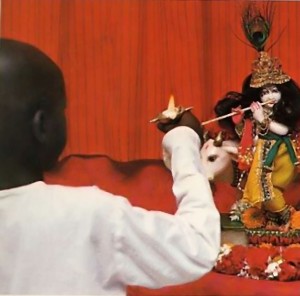
If someone hears about Gurukula second- or third-hand, he might think the children are deprived. But anybody who’s actually visited Gurukula can attest to the fact that the students are very happy. Our critics are always trying to find reasons why the children shouldn’t be happy, but the fact is that they are happy. In Dallas, I once had to do jury duty, and I got into a conversation about Gurukula with a woman waiting next to me. She accused us of brainwashing the children, and her main gripe was that we “don’t let them watch tv.” But I pointed out that tv is filled with violence, sex, commercials that induce us to act in certain ways, and stories that portray certain life-styles and activities as ideal. I turned her argument around by pointing out that she was brainwashing her children to be violent, sex-hungry, and so on. Well, she couldn’t say anything to that. The fact is that every parent and every teacher conditions the minds of the children in their care. The issue is not “brainwashing,” but rather the intrinsic value of what’s being taught. Everybody’s conditioned. But how we are conditioned; that’s the point. Is it harmful conditioning or beneficial conditioning?
Common sense tells us that a child has to be protected. A child crossing the street has to be protected. We may be restrictive, but it’s a good thing for the child. Anyway, when a child reaches a certain age he can be allowed to cross the street by himself. So, when our students are older and can understand the intricacies of society for themselves, then their exposure to these things won’t be harmful. But when they’re young, they’re very easily molded, and they have to be carefully protected.

We have to remember that the Gurukula children are acquiring not only an education but also a simple and pure culture: they’re learning devotion. Their education has a purpose. Srila Prabhupada has said the Gurukula students should grow up to be the leaders of our country. They won’t be recluses. They’ll be serving American society, and world society. Sometimes it may seem that we’re trying to build a kind of isolationist religious community, like the Amish have. But our students won’t be restricted in that way. They’ll be able to perform any activity in society. Of course, we’re mostly interested in producing teachers and advisors, because we feel this is the most critical need of society. The main problem in the world today is that there aren’t enough intellectual leaders who are devotees of God; this affects all the other social classes very much. So, our general principle is that if a student has a strong character and a good working understanding of Krishna consciousness, he can apply his Krishna consciousness to whatever he does in life and be an ideal example in society. That’s the kind of person we want to graduate from Gurukula.
The school’s director, Jagadisa dasa, replies to some often-asked questions.
BTG: How does Gurukula fit in with today’s society?
Jagadisa dasa: Today many people, especially the leaders, have given up the idea of good character and God consciousness. But with that mentality, no one can be peaceful or happy.
All of us in this world—we’re connected with one another; we’re like the limbs and branches of a tree. And we’re connected with God; He’s like the tree’s root. So if we all water the root, if we serve the Lord, then the tree—our whole world—will flourish. So we want the students at Gurukula to develop ideal character. They’ll have one aim in life: to serve the Lord and all living beings.

BTG: But how will these children function in society? They may develop “ideal character,” but how will they live in the everyday world twenty years from now?
Jagadisa dasa: In the Bhagavad-gita, Lord Krishna explains that according to the qualities of an individual’s work, he can serve in society in any one of four ways. The Bhagavad-gita describes the intellectual like this: “Peacefulness, self-control, austerity, purity, tolerance, honesty, wisdom, knowledge, and religiousness—these are the qualities by which the brahmanas work” (Bg. 18.42). Brahmanas are especially meant to teach the other classes and guide society along the spiritual path. So, when a child shows intellectual traits, we train him accordingly.
Then Krishna describes the administrators: “Heroism, power, determination, resourcefulness, courage in battle, generosity, and leadership are the qualities of work for the ksatriyas” (Bg. 18.43).
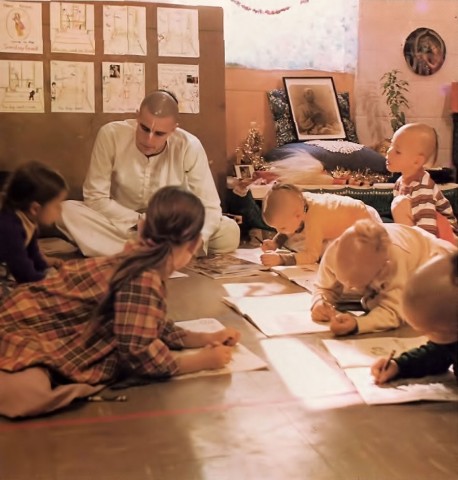
The brahmanas are men of first-class intelligence, the ksatriyas are men of second-class intelligence, and below the ksatriyas are vaisyas and sudras. So for the two other divisions of society, “farming, cow protection, and business are the kinds of work suitable for the vaisyas, and for the sudras there is labor and service to others” (Bg. 18.44).
Gurukula is especially meant to develop progressive persons who understand the spiritual values of life and make a contribution to human society. We are educating these boys and girls how to live a proper human life, whatever the social conditions. Then, wherever they may live and whatever they may do, if they remain Krishna conscious they will be happy and successful. This is the real point of Gurukula.
BTG: Could you tell us a little bit about what the children learn in terms of traditional subjects like math, science, social studies, history, and geography?
Jagadisa dasa: They learn English, math, geography, history, and so on, so that they can understand the modern world and be able to relate with people in an intelligent way. But the main thing is that the child learns the principles of Krishna consciousness.
BTG: How do you determine your teachers’ qualifications?
Jagadisa dasa: Our teachers are all good devotees. That’s the first prerequisite. They must carefully follow the regulative principles: no meat-eating, no gambling, no illicit sex, no intoxication. They must also be exemplary in their behavior: chanting the Hare Krishna mantra, attending temple functions, always keeping clean, and so forth. Basically they have to exhibit the characteristics of brahmanas (as I mentioned before, cleanliness, truthfulness, austerity, self-control, and so on). And if they have some material qualifications, so much the better. Most of our academic teachers do have teaching certificates, and they’ve had some teaching experience before coming to the movement.
BTG: Could you describe a typical day for a child in Gurukula?

Jagadisa dasa: The children rise early (along with their parents and teachers) and attend the temple functions from four-thirty till eight o’clock in the morning. This morning program provides the children with a firm Krishna conscious foundation for the rest of the day. At eight o’clock the children take breakfast, and by nine-thirty they’re in class. The first class period of the day stresses English and lasts until lunch, with a break in the middle to attend services in the temple. After lunch the older children chant the verses of Bhagavad-gita in the original Sanskrit language, and they learn the Sanskrit alphabet and grammar. This afternoon session lasts an hour to an hour and a half; then there’s math, geography, and history. After three-thirty the older children have free time, and the younger children have free time after two o’clock.
BTG: How does discipline fit into Gurukula’s educational picture?
Jagadisa dasa: In his letters to us, Srila Prabhupada has said that the children need two things: learning and love. As far as discipline, there should be no permissiveness, but at the same time there should be no strong punishment. Our teachers can help the children to become self-disciplined because they themselves are self-disciplined. That’s the Krishna conscious way to teach: not just by precept, but by example.
Born thirty-one years ago, in Cleveland, Ohio, Dvarakanatha dasa graduated from the University of Florida. In 1972 he began work at ISKCON’s Gurukula in Dallas as a math and English teacher, and the following year he served as the school’s assistant headmaster. In 1974 Dvarakanatha took his present post as a children’s counselor in Dallas and continues in this capacity at ISKCON’s Los Angeles center, where he lives with his wife Krishnapriya-devi dasi and their three children (Kamesi-devi dasi, eleven; Sammohini-devi dasi, seven; and Uddhava dasa, three).

ISKCON is doing marvelous job for the whole society by teaching children by gurukul systemof education.
All of them are nearer to supreme lord Krishna and so they are more perfect as a human being.
HARE KRISHNA
ISKCON gurukula school has done implanting the seed of devotional service unto the Supreme Lord Sri Krishna to the hearts of future leaders of THE WHOLE WORLD that is needed today, and in the future to come.
HARE KRISHNA